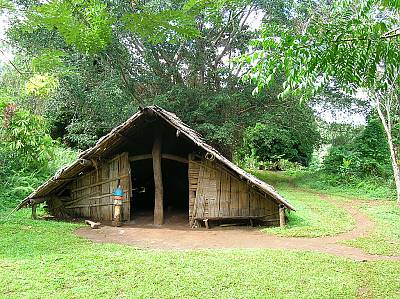- Vanuatu




Indigenous Architecture and Building Knowledge in Vanuatu

© “Nakamal” by Andrew Gray is licensed under CC BY-SA 3.0
1. ICH domains
Oral traditions and expressions, social practices, festive events, traditional craftsmanship2. Short description
Nakamals are traditional meeting places for Chiefs and other community leaders in Vanuatu and play a significant role in accommodating the functions for customary court sessions and ceremonies. In the true sense of the word, the nakamal means ‘the house of men’ and is a fairly long building whose different compartments symbolise the main divisions in rank or status. The nakamal is usually the most significant building in a village, and today provides space for broader community activities. These community activities include much of the transmission of communal knowledge - so nakamals are both the expression and the forum of much of the community’s most important intangible cultural heritage. It is usually constructed from local building materials using traditional construction techniques. Because of their design (with the roof usually reaching the ground level), they are able to withstand high winds and cyclonic conditions, providing enhanced protection from cyclonic winds.
Further information:
UNESCO has supported the region in preserving traditional architecture, including a project in Vanuatu aimed at documenting best safeguarding practices to encourage the revitalisation of indigenous building skills and ensure the continued existence of nakamals as a disaster risk mitigation measure. The project has contributed to social cohesion and sustainable development within the indigenous community of Vanuatu, and has increased awareness of the cultural significance of these buildings. For more information, see:
Vanuatu Culture Centre. 2017. Safeguarding Indigenous Architecture in Vanuatu. Final report on research carried out as part of a Post-Disaster Needs Assessment:http://unesdoc.unesco.org/images/0024/002481/248144e.pdf
For more on the effectiveness of nakamals in Vanuatu, see:
United Nations Office for Disaster Risk Reduction (UNISDR). 2015. Local knowledge saves lives in Vanuatu.
https://www.unisdr.org/archive/45870
3. Link with sustainable development
Nakamals are traditional meeting places for Chiefs and other community leaders in Vanuatu and play a significant role in kastom (custom/culture) in Vanuatu. The nakamal traditionally is the most significant building in the village, accommodating the functions for kastom governance, kastom court and other kastom ceremonies. It forms a valuable core of any village society to maintain peace and unity, and thus serves to echo SDG 11 in making human settlements inclusive, safe, resilient and sustainable, as well as SDG 16 promoting peace, justice, and strong institutions. It also echoes SDG 12 on responsible consumption and production through its sustainable use of locally found materials in its construction,
The important role that local knowledge can play in improving disaster preparedness and mitigation is increasingly recognised by specialists, particularly since the 2004 Indian Ocean tsunami. This is echoed in SDG 13 which, among other things, aims to strengthen resilience and adaptive capacity to climate-related hazards and natural disasters.
4. Questions for reflection
The viability of nakamals and nimaletens is facing several challenges including the proliferation of imported building materials and construction techniques, a lack of recognition of the value of this heritage by both communities and policy-makers, the shortage of raw materials and lack of resources required to renovate or reconstruct.
Research exists on questions such as indigenous concerns about self-reliance, cultural continuity, and looking at the impact and implications of the transition to a cash economy, of Western education and lifestyles and rural–urban migration on traditional knowledge relating to weather and climate observations. See for example Ainka Granderson’s research which looks at the potential trade-offs for indigenous communities, where traditional governance and values enable flexibility and collective action that build adaptive capacity but can also promote conservative attitudes and limit the uptake of new information and practices.
Granderson, A.A. 2017. The role of traditional knowledge in building adaptive capacity for climate change: perspectives from Vanuatu. Bulletin of the American meteorological society. Vol.9, pp. 545-561. https://journals.ametsoc.org/doi/pdf/10.1175/WCAS-D-16-0094.1
How can communities safeguard their traditional knowledge in a dynamic way, responding to changing environments and adapting accordingly?
Do you know of any examples where communities are facing challenges in safeguarding their traditional knowledge and practices?